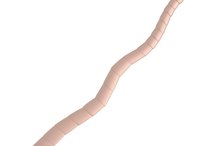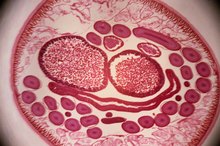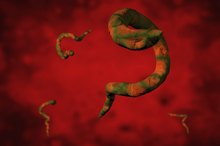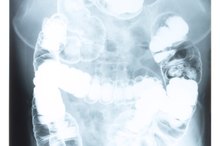Signs of Tapeworms
Tapeworms are a type of parasite scientifically classified as Cestoda that live in the digestive and intestinal tract of animals and humans. Tapeworms are sometimes referred to as flatworms and can reach lengths anywhere from a few inches to 40 feet or longer. There are four main types of human tapeworms: fish tapeworm (Diphyllobothrium latum), dwarf tapeworm (Hymenolepis nana), beef tapeworm (taenia saginata) and the pork tapeworm (Taenia solium). Tapeworms are generally ingested into the body through their eggs or larvae through food that is eaten.
Weight Loss
One of the most prominent signs of a tapeworm infestation is a significant weight loss. This symptom generally occurs when the host or person infected is eating normally and has no other underlying medical condition. The weight loss can be rapid, in some cases losing up to two to three pounds per week. This can lead to weakness and an overall feeling of malaise or discomfort.
- One of the most prominent signs of a tapeworm infestation is a significant weight loss.
- The weight loss can be rapid, in some cases losing up to two to three pounds per week.
Abdominal Discomfort
What Are the Effects of Tapeworms in Humans?
Learn More
Having some abdominal discomfort is common in people who have a tapeworm infestation. The discomfort can range from a mild fullness to severe cramping and pain. As the tapeworm grows larger over a period of a few months, the discomfort gradually worsens. The abdominal discomfort may get worse 30 minutes to an hour after a meal is consumed—this is when the tapeworm begins feeding.
- Having some abdominal discomfort is common in people who have a tapeworm infestation.
- The abdominal discomfort may get worse 30 minutes to an hour after a meal is consumed—this is when the tapeworm begins feeding.
Fecal Changes
A very prominent sign of being infested with tapeworms is seeing a change in the fecal matter or stool when using the toilet. As the tapeworm grows, small segments of the proglottids or tail of the tapeworm often tend to break off into the intestine. They are pushed through the intestines and passed out with a bowel movement. In cases where the tapeworm is quite large, it is possible that large parts of the proglottids or several-foot-long segments are pushed through the bowels during defecation.
- A very prominent sign of being infested with tapeworms is seeing a change in the fecal matter or stool when using the toilet.
- In cases where the tapeworm is quite large, it is possible that large parts of the proglottids or several-foot-long segments are pushed through the bowels during defecation.
Fever
Symptoms of Roundworms in People
Learn More
A sign that the tapeworm has gotten bigger and possibly begun to infect the digestive tract or surrounding areas could be the presence of a fever. The fever signifies that there is an underlying infection somewhere in the body. If the tapeworm is not killed or destroyed, it can grow out of control and begin to invade nearby organs and tissue. If this occurs, cysts can occur and often times burst, causing widespread infection. In some cases, the lumps can appear under the skin or appear tender to the touch. Any type of fever over 101 degrees should be evaluated by a medical professional immediately for proper treatment.
- A sign that the tapeworm has gotten bigger and possibly begun to infect the digestive tract or surrounding areas could be the presence of a fever.
- If the tapeworm is not killed or destroyed, it can grow out of control and begin to invade nearby organs and tissue.
Bacterial Infection
If tapeworm begins to spread, it is possible that it could lead to a bacterial infection within the body 2. The bacterial infection brings about more widespread symptoms such as diarrhea, body chills and isolated pain in the stomach or areas that are infected. There may also be a foul smell in the fecal matter if the infection is widespread throughout the digestive system and the bowels. In severe cases, tapeworm can cause an infection called cysticercosis 2. Cysticercosis is where cysts develop in various areas of the body from the embryo of the tapeworm. This condition can develop into neurocysticercosis where the worms can infect the central nervous system, causing brain disorders such as seizures and eventually death if left untreated 3.
Related Articles
References
- Tapeworm Information
- Tapeworm Infection Information
- Neurocysticercosis
- Centers for Disease Control and Prevention. Parasites: Taeniasis FAQs. Updated January 10, 2013.
- Centers for Disease Control and Prevention. Parasites: Hymenolepiasis FAQs. Updated January 10, 2012.
- Pearson R. Diphyllobothriasis (Fish Tapeworm Infection). Merck Manual Professional Edition. Updated July 2018.
- Pearson R. Taenia Solium (Pork Tapeworm) Infection and Cysticercosis. Merck Manual Professional Edition. Updated July 2018.
- World Health Organization. 10 facts about neurocysticercosis. Updated April 2017.
Writer Bio
Julie Boehlke is a seasoned copywriter and content creator based in the Great Lakes state. She is a member of the Society of Professional Journalists. Boehlke has more than 10 years of professional writing experience on topics such as health and wellness, green living, gardening, genealogy, finances, relationships, world travel, golf, outdoors and interior decorating. She has also worked in geriatrics and hospice care.









